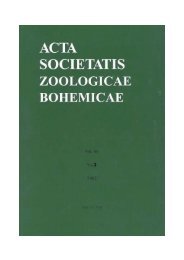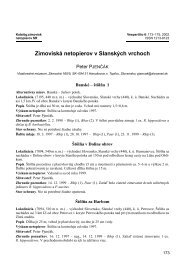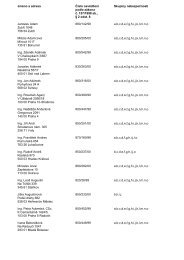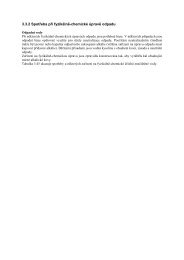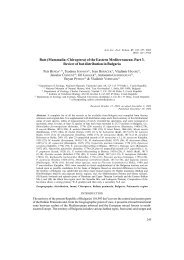Untitled
Untitled
Untitled
Create successful ePaper yourself
Turn your PDF publications into a flip-book with our unique Google optimized e-Paper software.
Shock metamorphism of some minerals: Basic introduction and microstructural observations<br />
Table 1. Compilation of the most abundant PDF orientations in shocked quartz.<br />
Miller indices {h k i l} Azimuth angle Pole distance ρ Symbol Form<br />
(0001) – 0° c basal pinacoid<br />
{101 — 3}, {011 — 3} p, n 30° 22.95° ω, ω’ rhombohedron<br />
{101 — 2}, {011 — 2} p, n 30° 32.42° π, π’ rhombohedron<br />
{101 — 1}, {011 — 1} p, n 30° 51.79° r, z rhombohedron<br />
{101 — 0} 30° 90° m hexagonal prism<br />
{404 — 1v, {044 — 1} p, n 30° 78.87° t rhombohedron<br />
{516 — 0}, {61 — 5 — 0} r, l 40° 90° k ditrigonal prism<br />
{516 — 1}, {61 — 5 — 1} p, n, r, l 40° 82.07° x trigonal<br />
{61 — 5 — 1}, {156 — 1} trapezoedron<br />
{314 — 1}, {43 — 1 — 1} p, n, r, l 45° 77.91° – trigonal<br />
{41 — 3 — 1}, {134 — 1} trapezoedron<br />
{213 — 1}, {32 — 1 — 1} p, n, r, l 50° 73.71° – trigonal<br />
{31 — 2 — 1}, {123 — 1} trapezoedron<br />
{112 — 2}, {21 — 1 — 2} r, l 60° 47.73° ξ trigonal dipyramid<br />
{112 — 1}, {21 — 1 — 1} r, l 60° 65.56° s trigonal dipyramid<br />
{112 — 0}, {21 — 1 — 0} r, l 60° 90.0° a trigonal prism<br />
{224 — 1}, {42 — 2 — 1} r, l 60° 77.20° trigonal dipyramid<br />
p = positive, n = negative, r = right, l = left<br />
amorphous lamellae and resultant exsolution<br />
of water. The exsolution of water can<br />
be attributed to the different solubility of<br />
water in silica glass and crystalline quartz.<br />
Therefore, the fluids mobilized in impact<br />
events can initially be dissolved in the<br />
amorphous PDFs but subsequent recrystallization<br />
of the glass expels the water in<br />
form of tiny voids (Goltrant et al. 1991,<br />
1992, Leroux and Doukhan 1996, Grieve et<br />
al. 1996, Langenhorst and Deutsch 1998).<br />
Sub-planar features of tectonic origin<br />
such as the so-called Böhm lamellae have<br />
been erroneously assigned as PDFs (Ernstson<br />
et al. 1985, Vrána 1987; Fig. 8a). TEM<br />
studies have deciphered the nature of these<br />
tectonic features, as being subgrain boundaries<br />
(Cordier et al. 1994, Langenhorst and<br />
Deutsch 1996, Joreau et al. 1997a). Subgrain<br />
boundaries are dislocation arrays,<br />
separating a crystal into sub-grains that are<br />
slightly tilted (< 5°) with respect to each other. They are<br />
the result of slow plastic deformation and recovery of deformed<br />
quartz in a tectonic environment. The deformation<br />
proceeds by the activation and emission of dislocations<br />
coupled with simultaneous or subsequent climb and recovery<br />
of dislocations into sub-grain boundaries (Fig. 8b;<br />
Poirier 1985). Water can easily penetrate along these internal<br />
boundaries leading to a decoration with water bubbles.<br />
A careful optical inspection of the suspected planar<br />
features in quartz will immediately reveal whether they are<br />
of endogenic or exogenic origin. Sub-grain boundaries<br />
show a sub-parallel arrangement but are not perfectly planar,<br />
unlike shock-produced PDFs. The spacing of tectonic<br />
features (usually > 5–10 µm) is larger than that of shockproduced<br />
PDFs (< 1 µm). Under crossed Nicols, the tectonically<br />
deformed quartz grains show undulatory extinction<br />
and can exhibit an anomalous optic axial angle of up<br />
to 10°. In contrast, shocked quartz usually shows a patchy<br />
extinction pattern, with extinct areas in different parts of<br />
the crystal. This behaviour is the so-called mosaicism. In a<br />
tectonic source rock, not all of the deformed quartz grains<br />
contain sub-grain boundaries in a sub-planar arrangement;<br />
many quartz grains may even be devoid of sub-grain<br />
boundaries. On the other hand, it would be rather unusual<br />
for an impact rock that only one or few quartz grains contain<br />
PDFs. If the quartz grains have experienced the same<br />
pressure-temperature conditions, then at least most of<br />
them should contain PDFs (Hörz 1968, Engelhardt and<br />
Bertsch 1969). The size and orientation of quartz grains<br />
with respect to the shock front has however an influence<br />
on the development of PDFs (Walzebuck and Engelhardt<br />
a<br />
50 µm 3 µm<br />
b<br />
Fig. 8. (a) Optical micrograph and (b) corresponding bright-field TEM image of subgrain boundaries in a tectonically deformed quartz from Azuara,<br />
Spain (see Langenhorst and Deutsch 1996).<br />
271



